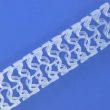Courtesy of Dr. Brian Nazareth Donato. The relative safety of drug-eluting stents (DES) and conventional bare-metal stents (BMS) in primary angioplasty (percutaneous coronary intervention, PCI) in patients with ST elevation myocardial infarction (STEMI) is still subject of debate. A search was carried out using Medline, CENTRAL, EMBASE, TCTMD and Cardiosource. There were 9673 patients included,...
BVS: Comparable to Second-Generation DES in Complex Lesions
A center carrying out a mid- to long-term follow-up of the performance of everolimus-eluting bioresorbable scaffolds (Absorb) observed that this new device has an acceptable rate of major cardiovascular events, when compared to second-generation drug-eluting stents. Furthermore, although the population was complex and non-selected, no cases of early thrombosis were reported. This study enrolled 249 patients...
Tissue Protrusion after DES: Adverse Events at Long Term?
Original Title: Tissue Protrusion after Stent Implantation. An ADAPT-DES Intravascular Ultrasound Substudy. Reference: Fuyu Qiu et al. J Am Coll Cardiol Intv. 2016;9(14):1499-1507. After DES implantation we may observe tissue protrusion (plaque or thrombus) relatively often, especially in unstable lesions; however, its clinical impact has not been studied. The aim of this study was...
DES in critical ischemia caused by infrapopliteal lesions
Original Title: Percutaneous Transluminal Angioplasty and Drug-Eluting Stents for Infrapopliteal Lesions in Critical Limb Ischemia (PADI) Trial. Reference: Marlon I. Spreen et al. Circ Cardiovasc Interv. 2016 Feb;9(2):e002376. The treatment of infrapopliteal lesions in patients with critical limb ischemia is limited by the high rates of restenosis. The most frequent course of treatment is...
Diabetes has higher impact on DES outcomes than disease complexity
Original Title: Impact of diabetic status on outcomes after revascularization with drug-eluting stents in relation to coronary artery disease complexity. Reference: Koskinas KC et al. Circ Cardiovasc Intv. 2016; Epub ahead of print Diabetic patients ongoing PCI with drug eluting stents (DES) are at higher risk of repeat revascularization than non-diabetic patients. According to this...
In saphenous vein graft lesions, 1st and 2nd generation DES have similar outcomes
Long-Term Outcomes with First vs. Second-Generation Drug-Eluting Stents in Saphenous Vein Graft Lesions. Nagendra R. Pokala. Catheterization and cardiovascular Intervention 2016;87:34-40 Courtesy of del Dr. Carlos Fava. Second generation DES have been proved superior to first generation DES in native arteries, but there is limited information on DES in saphenous vein grafts (SVG), from a...
Aspirin or Clopidogrel as Monotherapy after 12 month DAPT
Original Title: Clopidogrel versus Aspirin as an Antiplatelet Monotherapy after 12-Month Dual-Antiplatelet Therapy in the Era of Drug-Eluting Stents. Reference: Taek Kyu Park et al. Circ Cardiovasc Interv. 2016 Jan;9(1):e002816. Courtesy of Dr. José Amadeo Guillermo Álvarez. The use of dual antiplatelet therapy (DAPT) over 12 months after hospitalization for acute myocardial infarction (AMI) or drug...
ADAPT-DES: Proton Pump Inhibitors and Clopidogrel in Patients with DES
Original Title: Proton Pump Inhibitors, Platelet Reactivity, and Cardiovascular Outcomes After Drug-Eluting Stents in Clopidogrel-Treated Patients. The ADAPT-DES Study. Some proton pump inhibitors interfere with clopidogrel metabolism and could attenuate P2Y12 reception. Prior observational and randomized studies have reported contradicting results on the clinical significance of this drug interaction. The aim of this trial was...
DANAMI3: Primary Angioplasty to culprit vessel versus multivessel guided by FFR
The aim of this study was to compare the usefulness of primary angioplasty only to culprit vessel versus complete revascularization guided by fractional flow reserve (FFR) in patients admitted pursuing an acute myocardial infarction with ST-segment elevation and have multiple injuries vessels. After a successful primary angioplasty to culprit artery, patients were randomized 1:1 to...
CULPRIT: Complete revascularization versus culprit artery of infarct only
Current guidelines suggest treating only the culprit artery of myocardial infarction with ST-segment elevation. This prospective and randomized work included 296 patients in 7 centers suffering ST-segment elevation acute myocardial infarction referred for primary angioplasty randomized to treat only the culprit artery (n = 146) versus complete revascularization (n = 150). In the culprit artery...









